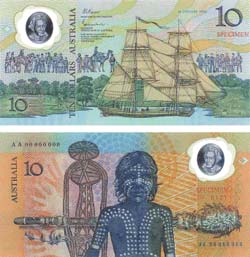Plastic Money

Counterfeiting money is the “second oldest profession in the world”—a profession that truly took off with the introduction of paper money. In order to spoil things for counterfeiters, Australia introduced the world’s first banknotes made of plastic in 1988.
David H. Solomon at the University of Melbourne was part of an interdisciplinary team of scientists that developed these bills. In an essay in the journal Angewandte Chemie, he and co-author Emma L. Prime trace the technically challenging route to the development of the plastic banknote.
In 1966, Australia converted its currency from the British Pound to the decimal system. The new banknotes distributed by the Reserve Bank of Australia (RBA) were at the time the most counterfeit-proof bills in the world. However, it was less than a year before counterfeiters tried to put the first forged $10 bills into circulation—ingeniously printed on common office paper. The Governor of the RBA, H.C. (Nugget) Coombs, thus initiated a project to secure banknotes against counterfeiters.
Solomon remembers a photographic expert on the commission, who countered nearly every suggestion with the words, “if you can see it, you can photograph it”—meaning that it was always possible to separate the colors of a banknote, produce printing plates, and forge the bills. “Our idea was to develop materials that could not be photographed,” reports Solomon, “which eventually led to the use of clear plastic films as a substrate in place of paper.” A banknote with a transparent window made of a plastic film is a simple but highly effective security feature. The material selected was a polyethylene/polypropylene/polyethylene film. Two or three of these three-layer films were combined in a hot lamination process to attain the required thickness of 80 to 90 µm.
Another security feature is a small picture in the transparent window that is designed to produce a complex diffraction grating through the diffraction and interference of light. To protect the diffraction grating and to achieve the right “feel”, the entire banknote then had to be covered with a clear polyurethane coating. The team was able to develop a production process that put everything together in a single run: lamination, application of white ink, printing the pattern, hot embossing the diffraction grating, application of the clear coat, and cutting. In stringent tests, the sample banknotes proved to be more durable than the paper banknotes in circulation – to such an extent that the higher production costs were easily balanced out.
In 1988, the RBA first introduced a limited number of a special $10 banknote for the Australian bicentennial celebration (see picture). Between 1992 and 1996, the Note Issue Department then replaced all Australian paper banknotes with plastic ones. “Since that time, other countries have adopted our technology,” says Solomon. “In Romania, New Zealand, and Brazil, the counterfeiting rate went down by over 90 % upon introduction of plastic bills.”
Author: David H. Solomon, University of Melbourne (Australia), http://www.chemeng.unimelb.edu.au/people/staff/solomon.html
Title: Australia's Plastic Banknotes: Fighting Counterfeit Currency
Angewandte Chemie International Edition 2010, 49, No. 21, Permalink to the article: http://dx.doi.org/10.1002/anie.200904538
Media Contact
All latest news from the category: Life Sciences and Chemistry
Articles and reports from the Life Sciences and chemistry area deal with applied and basic research into modern biology, chemistry and human medicine.
Valuable information can be found on a range of life sciences fields including bacteriology, biochemistry, bionics, bioinformatics, biophysics, biotechnology, genetics, geobotany, human biology, marine biology, microbiology, molecular biology, cellular biology, zoology, bioinorganic chemistry, microchemistry and environmental chemistry.
Newest articles

Properties of new materials for microchips
… can now be measured well. Reseachers of Delft University of Technology demonstrated measuring performance properties of ultrathin silicon membranes. Making ever smaller and more powerful chips requires new ultrathin…

Floating solar’s potential
… to support sustainable development by addressing climate, water, and energy goals holistically. A new study published this week in Nature Energy raises the potential for floating solar photovoltaics (FPV)…

Skyrmions move at record speeds
… a step towards the computing of the future. An international research team led by scientists from the CNRS1 has discovered that the magnetic nanobubbles2 known as skyrmions can be…





















